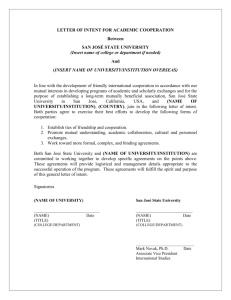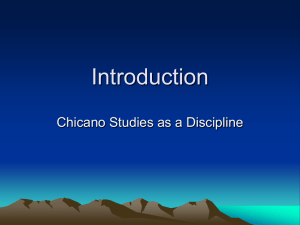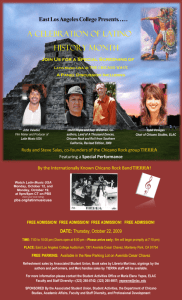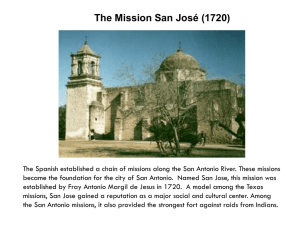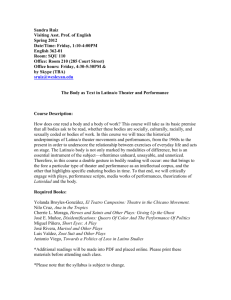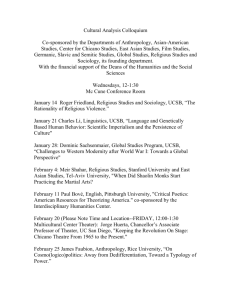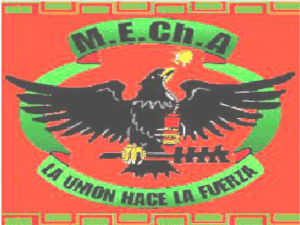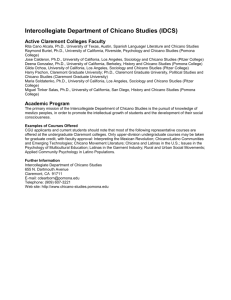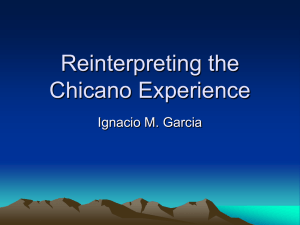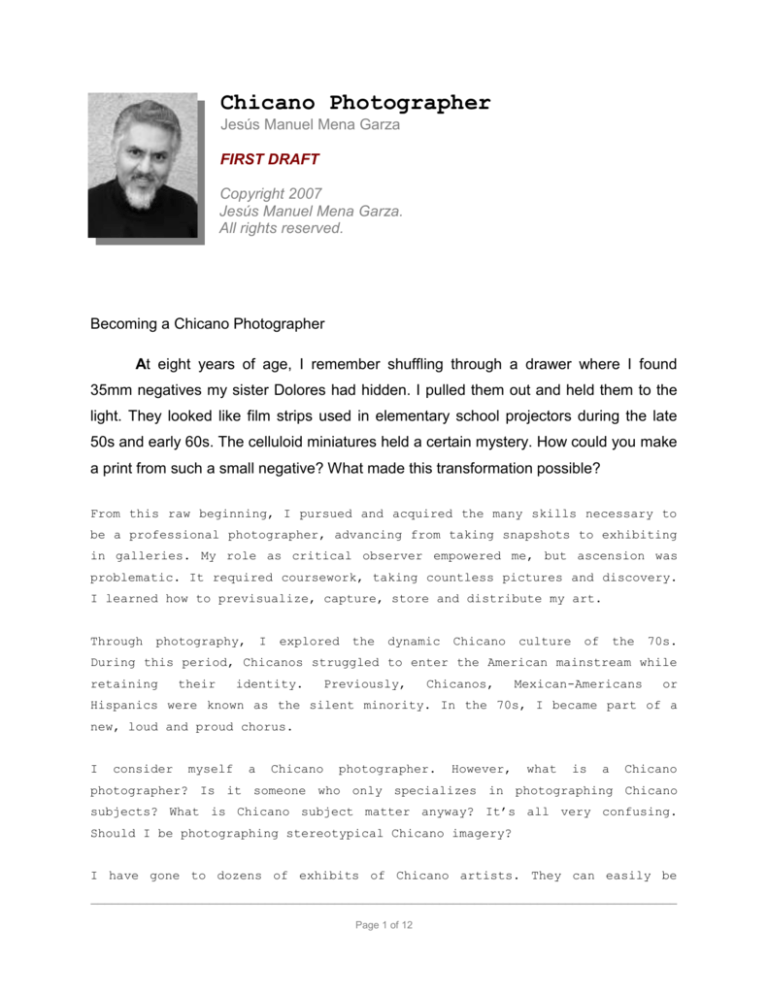
Chicano Photographer
Jesús Manuel Mena Garza
FIRST DRAFT
Copyright 2007
Jesús Manuel Mena Garza.
All rights reserved.
Becoming a Chicano Photographer
At eight years of age, I remember shuffling through a drawer where I found
35mm negatives my sister Dolores had hidden. I pulled them out and held them to the
light. They looked like film strips used in elementary school projectors during the late
50s and early 60s. The celluloid miniatures held a certain mystery. How could you make
a print from such a small negative? What made this transformation possible?
From this raw beginning, I pursued and acquired the many skills necessary to
be a professional photographer, advancing from taking snapshots to exhibiting
in galleries. My role as critical observer empowered me, but ascension was
problematic. It required coursework, taking countless pictures and discovery.
I learned how to previsualize, capture, store and distribute my art.
Through
photography,
I
explored
the
dynamic
Chicano
culture
of
the
70s.
During this period, Chicanos struggled to enter the American mainstream while
retaining
their
identity.
Previously,
Chicanos,
Mexican-Americans
or
Hispanics were known as the silent minority. In the 70s, I became part of a
new, loud and proud chorus.
I
consider
myself
a
Chicano
photographer.
However,
what
is
a
Chicano
photographer? Is it someone who only specializes in photographing Chicano
subjects? What is Chicano subject matter anyway? It’s all very confusing.
Should I be photographing stereotypical Chicano imagery?
I have gone to dozens of exhibits of Chicano artists. They can easily be
____________________________________________________________________________________
Page 1 of 12
divided into two categories. One large group consists of the Frida Kahlo
wannabees. The second category is resplendent with independent thinkers. Both
are valid.
Frida’s legacy is manifest in the work of many contemporary artists. Frida
will never die as long as dozens emulate her. This genre contains at least
one
of
the
following
naiveté
representations;
the
maguey,
sacred
heart,
Virgen de Guadalupe, a struggling woman, roses and such. When I enter an
exhibition and discover examples of this formulaic work — I always have the
refreshments to look forward to.
I consider myself in the latter category — an independent thinker. I am not
limited to preconceived notions of Chicano art. Chicano art is a hybrid of
the Mexican and American experience. That experience is constantly evolving.
It’s also nuanced by region, gender and other variables. Personally, I have
used my camera to explore the Chicano Movement, Americana, models, and much
more.
Yes,
I
have
also
photographed
representations
of
the
Virgen
de
Guadalupe.
I am a Chicano — and proud of it. Please don’t call me Hispanic. I am also a
trained photographer. When all is said and done, I identify as a Chicano
Photographer.
The Photograph
What makes a great photograph? I feel there is no defined process to
achieve this goal. There is plenty of room for interpretation. Fine art
photography requires two distinct skills — technical and aesthetic. To be a
great photographer you must combine the two. The works of icons Ansel Adams,
Edward Weston and Richard Avedon have influenced me in this regard.
Warhol
is
another
favorite.
His
audacity
and
marketing
shrewdness
have
inspired me and made me laugh. Warhol was truly a master marketer. He was at
his best when he not only mocked his project, but himself, the fine art
community and art production. What I would I have given to be part of The
Factory scene! Would I have survived the insanity?
Another artist who influenced me was Diane Arbus. Her photographs of “freaks”
____________________________________________________________________________________
Page 2 of 12
published in the 60s opened my eyes. She exposed beautiful people and common
people as well. Her lens was uncompromising.
The Birth of a Photographer
My parents could not afford a camera or record player. Therefore, at
age eleven, I bought my first camera at La Pulga, the San José Flea Market.
This simple twin lens box camera captured my initial portraits of close
friends
and
neighborhood
buildings,
subjects
I
would
continue
to
record
throughout my career, but on a grander scale.
I
processed
my
first
exposed
rolls
of
film
at
Arena’s
Photography
on
Thirteenth Street in San José. There, Gaetano Arena magically transformed my
negatives into prints. At least then, I thought it was magic.
From the beginning, my images had as their source my migrant farm worker
heritage and my immersion in the dynamic political and artistic culture of El
Movimiento, the political movement that emerged during the mid-60s seeking
social justice for Chicano/as.
Texas, California, y Mi Familia
My story, at least in the beginning, is similar to many other Chicanos and
Chicanas. My parents were modest farm workers. I was born in beautiful San José,
California in 1952, the seventh of eight children born to Eusebio and Guadalupe
Mena Garza.
Guadalupe was born in 1914 in Carrizo Springs, Texas, and grew up in nearby
Crystal City. My father, Eusebio, was born in 1907. He hailed from Coahuila
in Northern Mexico and came to Texas as a child in 1916. The Garza family
settled in Crystal City where Eusebio later met and married my mother.
My parents worked their entire lives as farm laborers. Like many campesinos
(farmworkers)
in
Crystal
City,
the
whole
family
migrated
throughout
the
Midwest and western regions of the United States during the harvest season.
Each winter they would return home.
In the late 40s, Manuel, my father’s eldest brother, led the extended Garza
____________________________________________________________________________________
Page 3 of 12
family to San José in search of increased opportunities. There again the
whole Garza family worked in the fields while living in various migrant labor
camps. We picked fruit and vegetables at orchards and farms that later became
prized locations for the computer industry’s chip manufacturing plants.
Growing up in San José during the 50s and 60s, I saw my hometown evolve from
an
agricultural
oasis
south
of
San
Francisco
to
the
capital
of
Silicon
Valley. During this period, my parents bought a house in a racially diverse,
working-class neighborhood in the city’s Northside.
Guadalupe eventually began working at local canneries, although she continued
laboring in the fields. I worked in the fields during summers, on weekends
throughout my school years, and occasionally in college. Manual labor is
always a valuable commodity.
My parents were quite humble. I do not remember having any long conversations
with either of them. My father usually sat in the corner reading the Spanish
language newspaper. He also loved listening to Spanish language radio.
Eusebio was very proud of his Mexican heritage and South Texas culture. I
shared his love of Tejano music, dancing and spicy cuisine. To this day, I
share this aspect of his South Texas soul.
My mother could not read or write, but she had a keen mind. She knitted,
crocheted, made quilts and clothing like many mothers of her period. She
enjoyed gardening and especially tending to her roses. I share her passion
for flowers.
My mother and I returned to Crystal City several times to see members of the
familia that had remained behind. When I was ten years old, I traveled with
my mother, my brother David and my sister Dolores’ in-laws. We stuffed eight
people into a car. The trip lasted more than 24 hours.
During this trip, I distinctly remember that I saw a sign posted on a dusty
rural Texas saloon stating, “No Mexicans or Dogs Allowed.” Although the
adults
ignored
the
sign
and
entered
the
saloon
without
incident,
the
experience exposed to me a new Southern reality.
____________________________________________________________________________________
Page 4 of 12
I
was
in
Crystal
City
in
1969
during
the
historic
high
school
walkout.
Chicano/as protested racist policies that denied them opportunities typically
afforded Anglo students. In this small Texas town, I witnessed the impact of
poverty,
segregation
and
activism,
an
encounter
that
shaped
my
future
political and community involvement.
The Teen Years
My artistic vision was shaped and nurtured at Roosevelt Junior High,
San
José
High,
San
José
State
University
(SJSU),
the
San
Francisco
Art
Institute, and the Academy of Art College (now University).
As
a
photographer,
upheaval
in
the
I
early
used
70s.
my
I
camera
focused
to
my
explore
lens
and
on
document
the
the
developing
social
Chicano
consciousness. I took my camera everywhere, capturing on film everything I
could. I was voracious.
At Roosevelt Junior High, I had my first exposure to the magic that takes
place in the darkroom. I was hooked. In high school, I started taking classes
in photography. At San José High, I shot countless rolls of film, honing my
eye and craft. I began to articulate my photographic style and technique.
My instructors, Prospero Anaya and Ron Root, closely guided me in coursework
every semester during high school and exposed me to the artistic environment
of Bay Area galleries and museums during field trips with the Photo Club. As
a result, when I graduated in 1970, I had an excellent understanding of
photographic processes, techniques and equipment.
Drawn to the position of outside observer, the documentation of people and
events formed the primary focus of my initial photographic work. I served as
photographer
for
both
the
school
newspaper
and
yearbook
and
discovered
photojournalism as my calling.
My photo assignments included everything from football games to proms. It was
a great experience. I did not date in high school because I was in love with
photography.
____________________________________________________________________________________
Page 5 of 12
San José High was one of the few schools at that time to have a photo lab.
Photography was offered for only one semester to most students, but I was
allowed to take classes every semester. The photo lab and studio were now my
home and refuge. I was called “Flash” or “Photo Man” — I did not mind.
Photography inevitably transformed an introverted outsider into an outspoken
activist and artist. The craft forced me to confront what I saw and to come
to terms with it. I made friends and fell into the role of documentary
photographer — the school archivist. I still posses most of my negatives,
clippings and mementos from this period.
People love to be photographed. This helped me gain access to worlds I would
otherwise
have
been
excluded
from.
I
hung
out
with
jocks,
cheerleaders,
faculty and many other diverse cliques. I moved seamlessly between them. I
had a sense of control for the first time in my life. I felt I was on the
verge of self-fulfillment. I decided to go to nearby San José State College
(later University) and become a photojournalist.
Growing Up Chicano
My parents left me to do my own thing when I turned 18. They weren’t
strict — generally oblivious. I converted my parent’s old garage into a
hippie
palace.
I
had
all
the
necessities
of
life
including
a
king
size
waterbed, stereo, sofa, and dozens of political posters. Covering a large
window with the ubiquitous upside down American flag was my not so subtle
protest against the war in Viet Nam.
My parents never understood the value of an education. I believed that they
were not on my side. I had to make life-changing decisions on my own. My
father expressed on many occasions that being a laborer was good enough for
me. He never went to college (nor elementary school) — why should I?
Some background — I don’t remember my father ever going to a parent teacher
conference. My mother, despite being illiterate, went several times. Any time
I needed a note for being absent from school she would sign whatever I wrote.
My parents spoke only Spanish at home. My schoolteachers taught me English.
Surprisingly, my parents got this one right because I never developed a
____________________________________________________________________________________
Page 6 of 12
“barrio” accent and could read and write both languages well. My father was
quite
meek.
I
never
saw
him
with
a
friend.
He
was
afraid
to
confront
authority. In contrast, I was rebellious, the polar opposite of my dad.
Eusebio did what he was told. In 1971, the police were looking for someone in
the neighborhood. Rather than saying no, he let them search my garage bedroom.
That day I lay ill with the flu. My girlfriend was visiting and had brought me
a bowl of hot soup.
One officer caught a glimpse of me and said, “You disgust me.” I did not
remember asking for his opinion. By his expression, I could tell he did not
like the lefty posters, waterbed, upside down American flag, etc. Obviously,
I was not a member of the Young Republicans.
The Chicano Film Institute
Immediately
out
of
high
school,
I
worked
as
a
photographer
and
cinematographer at the Chicano Film Institute (CFI) of San José. It was an
excellent opportunity to document Chicano/as in Santa Clara Valley. I shot
16mm film of Teatro Campesino, slides for a presentation on de jure and de
facto housing patterns in Santa Clara County, and many other projects. I
began to identify as a “Chicano Photographer.”
I worked for Ben Ybarra at CFI for about two years and sometimes donated my
check so the nonprofit could stay afloat. Not that I was asked. I could have
used the money for more camera equipment. At CFI, I enjoyed the camaraderie
of
other
Chicano/a
activists.
This
collective
was
my
first
eye-opening
glimpse into the complex world that was the 70s.
I have many stories from the 70s. For example, I used to walk around the
neighborhood of SJSU with a 16mm film camera. I had no film, but practiced
zooming, panning and composing. One day, a San José police officer saw me and
quickly grabbed my arm demanding, “Where did you get that camera?” I noted
that I was a cinematographer and that I worked around the block.
He responded abruptly, continued to interrogate me for several minutes and
said that he would throw me in jail. Such is the life of a longhaired lefty.
This was not the first time I was hassled and it would not be the last.
____________________________________________________________________________________
Page 7 of 12
La Vida Suave - College Life
At an early age, I knew I would attend San José State College. I
investigated their Journalism Department, knew the school had an excellent
reputation, and that Dr. Joe Swan would be an excellent teacher.
For me, and many others, college was an opportunity for personal growth. I
felt
that
there
were
no
boundaries.
This
was
the
early
70s.
There
were
hippies, be-ins, demonstrations, marijuana, miniskirts, Free Love and college
classes too.
As a photographer, I found plenty of creative opportunities. My camera was an
excellent tool for personal expression. I had my first photo exhibit at SJSU
the summer before I entered college. There would be many to follow.
In college, I was exposed to new people, ideas, and erupting emotions. At San José
High I never dated, I was the person who took pictures. In college things changed
— but not quickly.
Because I was poor at managing my finances, I moved from home to an apartment
and then back home again. I spent most of my cash on photography. I owned an
expensive Hasselblad at age 18. Today, my wife does most of the finances.
By the way, it took eight years for me to finish college. I was the first and
only one in my family to go to a university, and I did not have anyone to
guide me through the process. I probably took too many esoteric classes. In
retrospect, I should have finished in four years.
Not many Chicanos of my generation had the opportunity to take classes, join
clubs and investigate new cultures. At SJSU, I served as president of three
campus organizations and was a member of the UFW Support Committee and the
Community
Alert
activities.
Patrol,
Through
my
or
CAP.
political
Here
I
monitored
involvement,
I
and
met
documented
César
Chávez,
police
Corky
Gonzales, José Angel Gutiérrez and other Chicano/a leaders.
In high school, I learned basic serigraphy. I used these skills to help
support myself in college. At various screen shops, I did everything from
____________________________________________________________________________________
Page 8 of 12
constructing screens to printing. It was great training for making Chicano
Movement posters and flyers. Serigraphers Andy Warhol and Malaquías Montoya
were my artistic inspiration.
Now Hear Me! College Radio
In
1973,
I
expanded
my
creative
endeavors
from
photography
to
broadcasting. In college, I produced radio programs with the Latino Radio
Collective,
president
known
of
simply
C/N,
I
as
La
helped
Cosa
develop
Nueva
unique
(C/N).
As
bilingual
member
radio
and
later
programs
for
several Bay Area stations including KSJS, KPFA-B and KKUP.
These Chicano/a-centric programs featured news, public affairs and music from
groups popular in the period like Malo, Azteca, Sapo and Santana. We also
played
traditional
Tejano,
Mexicano
and
Salsa
music.
This
eclectic
mix
included artists like Little Joe, Javier Solis and El Gran Combo.
During the 70s, La Cosa Nueva’s programs could be heard throughout the San
Francisco Bay Area and parts of the San Joaquin Valley. La Cosa Nueva also
held benefit dances and worked in support of progressive political causes.
We had a great time working in radio. It was not uncommon to mix alcoholic
drinks (among other things) and party at the KSJS studios. It is my firm
belief that some people participated in the political struggles of the period
because of a deep-felt commitment to the cause. Others participated because
they wanted to party. Both were valid reasons.
El Centro Cultural de La Gente
Concurrently
communities,
I
with
served
my
involvement
as
in
Treasurer,
the
Gallery
university
and
broadcast
Director
and
Resident
Photographer at El Centro Cultural de La Gente of San José where I helped
produce various exhibits of my work and other San José and Bay Area artists.
In
addition,
I
continued
to
exhibit
my
work,
including
serigraphs
in
galleries throughout the Bay Area and Mexico. This included a group show in
1974 at the Galeria de La Raza in San Francisco. I also sent my complete
collection of serigraphs for exhibition in Mexico City at the request of a
____________________________________________________________________________________
Page 9 of 12
Mexican arts group. That was a big mistake (yes, I was naïve). This large
collection
of
one-of-a-kind
prints
was
never
returned.
That
same
year
I
helped curate the first major group exhibition of Chicano/a art for the San
José Museum of Art. I consider this exhibition a watershed moment in Chicano
art.
Later that year, I toured Mexico as resident photographer with Teatro de La
Gente, Teatro Campesino, Teatro Quetzal and others as part of the Quinto
Festival
de
Teatro
Chicano.
This
theater
conference
and
series
of
performances, organized by Adrian Vargas and members of Teatro Nacional de
Aztlán, was the first major conference in Mexico City to bring together
theater workers from the United States, Mexico and Latin America.
After seeing my work increasingly include fine art photography, close friend
Antonio Perales Fierro, who had previously attended the San Francisco Art
Institute, suggested that I consider expanding my artistic training. After
reviewing my portfolio, the prestigious Institute offered me a full tuition
scholarship that I accepted in the fall of 1974.
While I enjoyed the short respite from San José’s more traditional art scene,
criticism of my “Mexican” subject matter prompted me to return to San José by
mid-semester and I finished my degree at SJSU in 1978.
Hell No, I Won’t Go!
America sent thousands to die in Viet Nam from 1959 to 1973. Many 18
year-olds
were
snatched
out
of
working
class
neighborhoods
to
fight
in
Southeast Asia. I remember how the war shattered many families in San José.
Not having a college deferment (or connections like George W. Bush) meant a
one-way ticket to Viet Nam. Boys I knew in high school became missing, dead or
maimed in Nam. My high school newspaper regularly listed the names of past
students who died.
I recall that approximately 20 percent of the casualties in Viet Nam were
Chicano, while La Raza made up only 2 percent of the college ranks. Being
fodder for Lyndon Baines Johnson’s war was not for me. I was the rare Chicano
who enjoyed the option called life because I had a college deferment. That
____________________________________________________________________________________
Page 10 of 12
piece of paper saved me from the draft.
When the Washington elite decided to implement the draft lottery, I thought
my luck had run out. My draft number was eight. According to the goofy
system, your chance for induction increased with a lower number. I was behind
the proverbial 8-ball.
My father told me that I should enlist. He also gave me the advice that
college and high school were a waste of time and that I should be a man — a
soldier — I should enlist. My father, the meekest of men, had no right to
tell me what to do.
Being the antiwar zealot, I knew that there must be a way to get out of this
fight. I took the initiative and asked to be grandfathered in because of my
student deferment status. It worked.
Is There Life After Photography?
Being the opinionated Chicano that I am, I love being in front of the
camera and behind the microphone. After doing several years in La Cosa Nueva
gratis (free), it was time to be paid. That summer I married my first wife,
Esperanza, a member of Teatro de La Gente. While completing my journalism
degree, I worked for a year at San José’s KXRX/KEZR radio in 1975. Then I was
offered a better job and moved to Salinas in 1976 to serve as a sports anchor
and reporter for KSBW Television.
Six months later, I took over the helm at radio station KOMY in Watsonville.
At this bilingual radio station, I produced an eclectic mix of news, public
affairs and news. The experience left an indelible mark, making me keenly
aware of the power of electronic media and technology in our society.
By 1980, I moved back to San José and renewed my photography career by
opening FotoMedia in downtown San José. In addition to producing photography
workshops,
I
provided
a
range
of
media
services
including
photography,
advertising, graphic design, and public relations. I was exited to be back in
San José… taking pictures.
____________________________________________________________________________________
Page 11 of 12
c/s
____________________________________________________________________________________
Page 12 of 12

